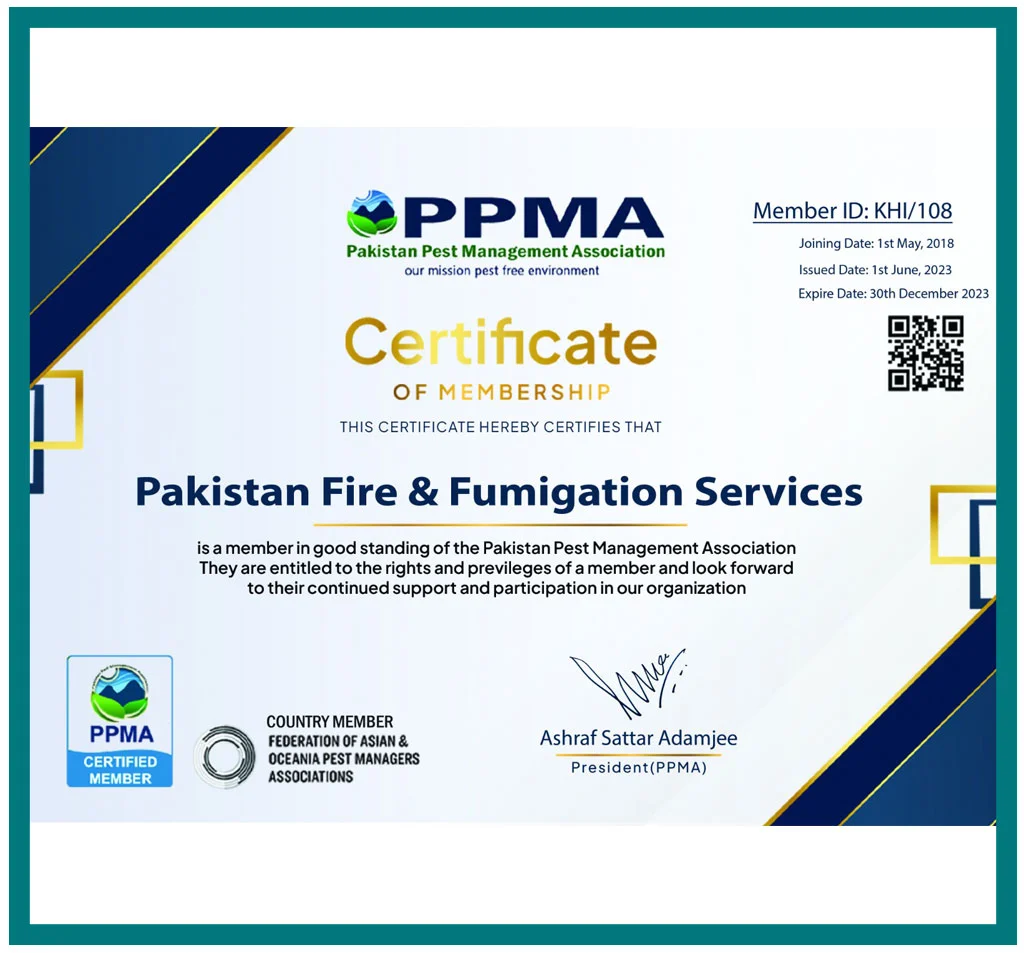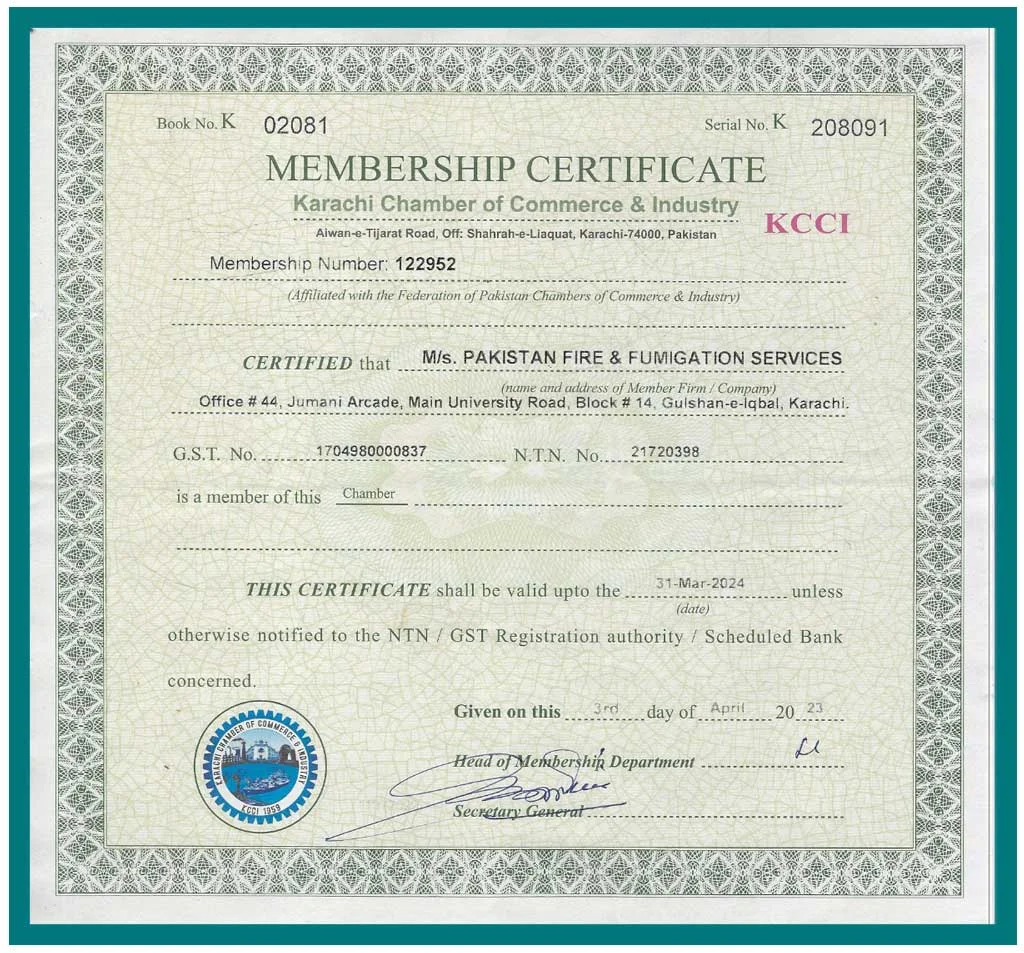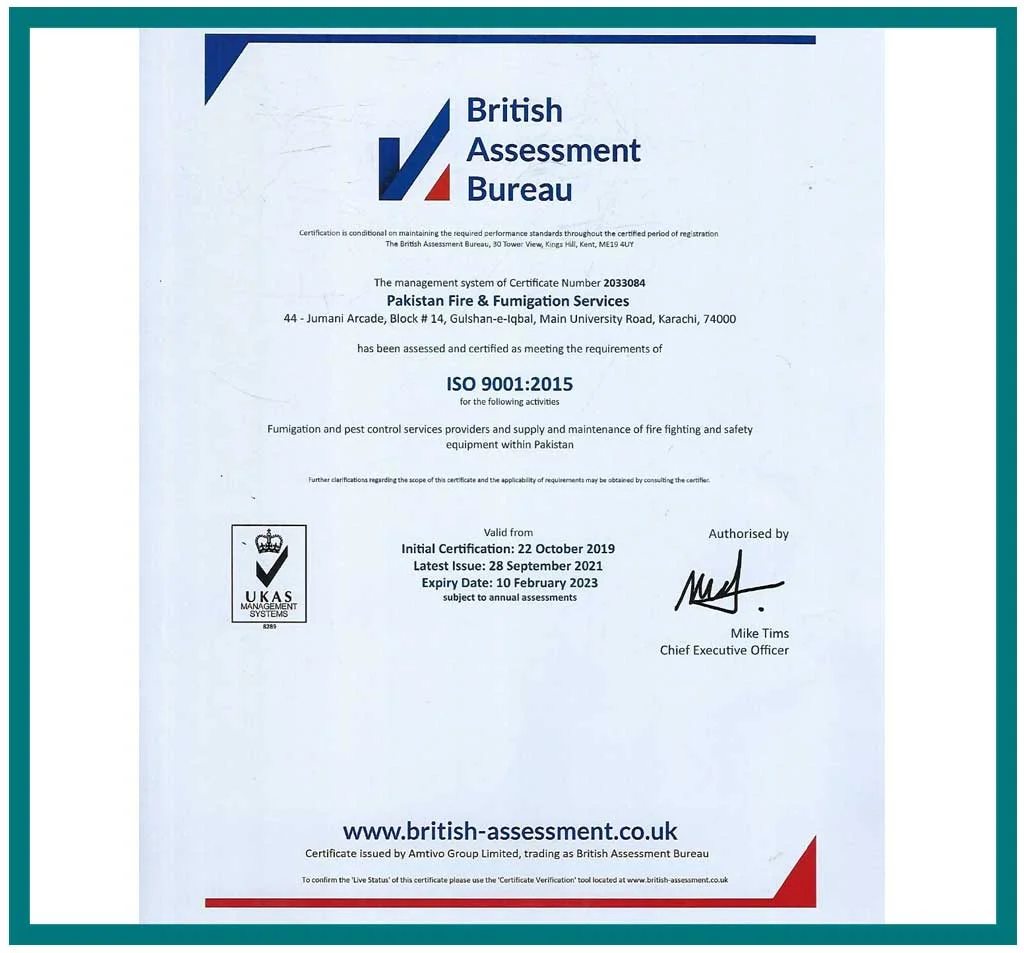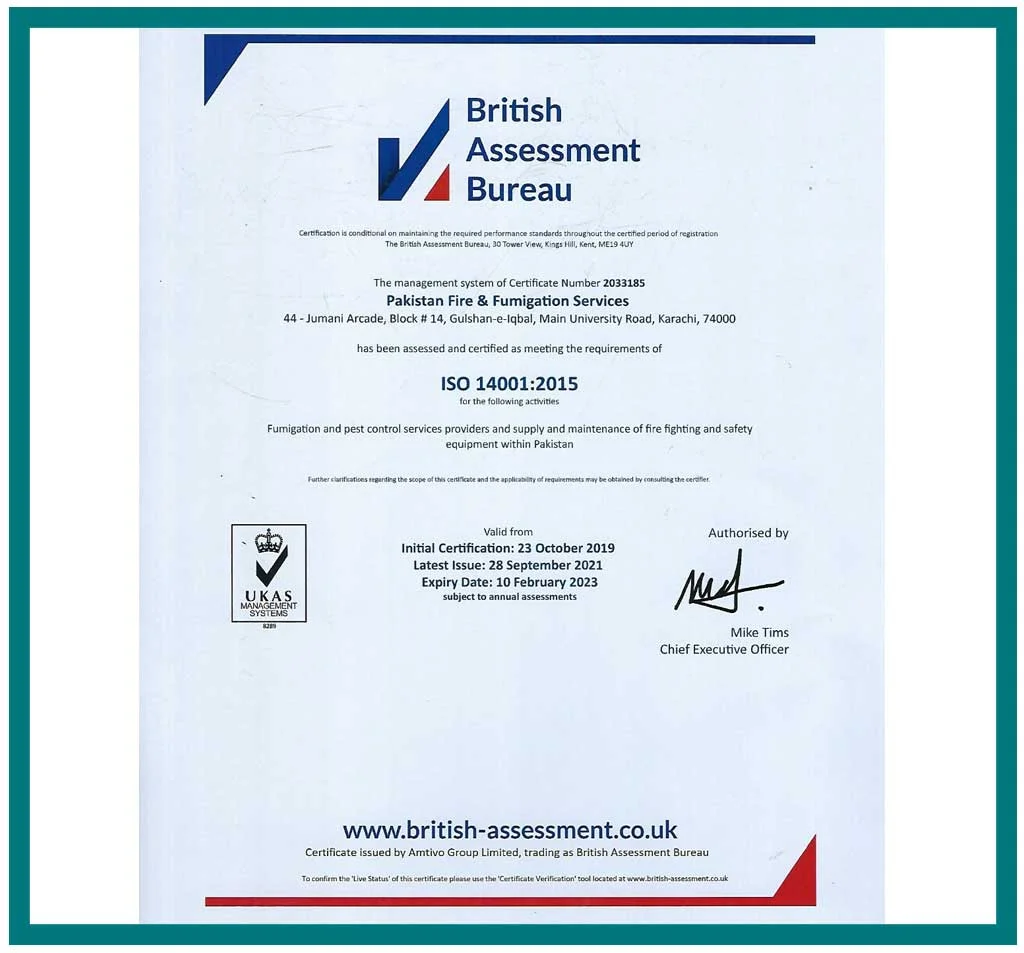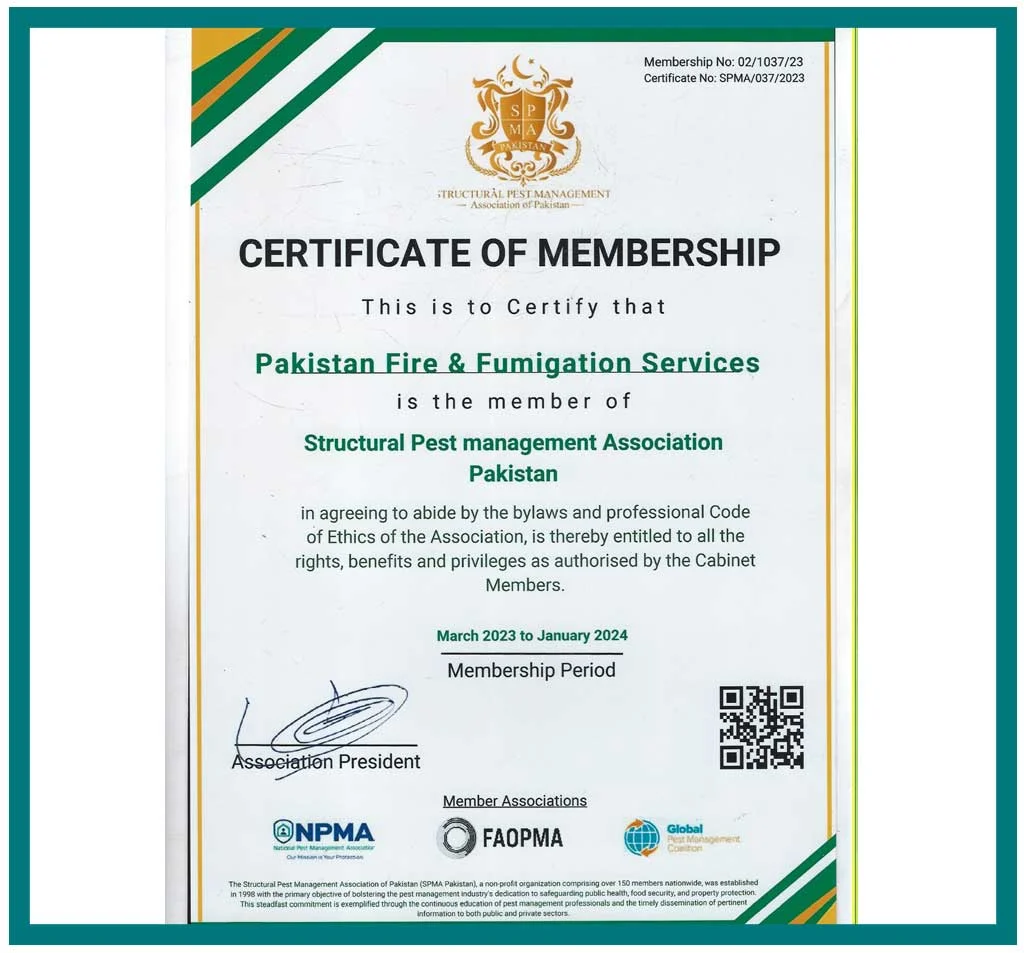Commercial Fumigation Services in Pakistan
If pests are threatening your stock, your audit results, or your export schedule, Pakistan Fumigation helps you restore control—safely and with minimal downtime. From mills and warehouses in Karachi to food processing, retail, offices and healthcare across Pakistan, our commercial fumigation programs are designed around your business hours, compliance needs, and building constraints. Every project begins with a practical risk assessment and ends with clear documentation your team can show to management, auditors, or port authorities.
Talk to a specialist: +92 331 8496210. Head Office: C-40, Bantva Nagar, Liaquatabad Town, Karachi. Night and weekend service windows available by arrangement.
When Your Business Needs Fumigation
Signs & risks you can’t ignore
Commercial facilities in Pakistan face a familiar mix of threats: stored-product insects in grain and packaged foods, cockroaches in food-contact zones, and termites undermining structures and fixtures. Warning signs include live or dead insects near raw materials, fine dust or “frass” around pallet edges, webbing or larvae in silos or stacks, unusual odors in sealed rooms, and customer-visible sightings on front-of-house floors. In offices and corporate buildings, night-time sightings of roaches around pantries and server rooms often signal an infestation migrating through conduits and false ceilings.
Left unchecked, infestations escalate quickly in our climate. Warm temperatures and monsoon humidity accelerate egg-to-adult cycles, turning a “localized” problem into a facility-wide issue. In mills and distribution warehouses, even a small hot spot can seed multiple areas via forklifts, trolleys, and packaging. For grain handlers and food processors, a live insect find can trigger non-conformance, batch holds, or outright rejections. In multi-tenant sites, a single unit’s pest pressure can spread through shared shafts, making building-wide coordination essential.
Business impact in Pakistan’s operating environment
The direct costs are obvious—stock loss, rework, and sanitation—yet the indirect costs are often larger. Production downtime to empty, tarp, treat, and aerate a zone can disrupt delivery windows that your customers and distributors rely on. At Karachi Port or Port Qasim, delays from contaminated or untreated containers can cascade into missed sailing cut-offs and extra storage charges. For exporters of rice, wheat, pulses, nuts, or spices, a hold due to live insects or incomplete treatment records can jeopardize a whole shipment, not just one container.
Local operating realities add complexity. Power load-shedding can affect ventilation timelines; high ambient temperatures change aeration dynamics; and urban traffic restricts safe fumigant logistics and crew movement. Hospitality and healthcare sites face reputational and safety stakes: a single guest video of a cockroach, or a clinic area closed without explanation, can draw public scrutiny. Effective commercial fumigation in Pakistan therefore isn’t just about “killing pests”—it’s about planning around your shifts, your compliance calendar, your export schedule, and your brand exposure so the business keeps moving.
Note: Specific fumigation methods, concentrations, and re-entry times depend on your facility, commodities, and legal/safety requirements. We’ll recommend options after a site survey.
Our Commercial Fumigation Process
Site survey & risk assessment
Every job starts with a structured walk-through of your facility to understand layout, ventilation paths, product flow, and pest pressure. We map priority zones such as receiving bays, production lines, silos, racking aisles, canteens, and electrical rooms, then check for potential gas-leak points like roller shutters, cable penetrations, and roof sheeting overlaps. Where needed, we conduct gas-tightness checks on rooms or stacks and note sensitive areas—server rooms, oxygen-rich medical spaces, or areas with continuous processes that cannot be shut down. You’ll receive a concise pre-treatment checklist covering stock segregation, equipment masking, signage, and staff notifications so prep work is predictable and safe.
Because Pakistan’s climate and infrastructure affect fumigation dynamics, our risk register specifically accounts for temperature, humidity, and power reliability. For example, in coastal Karachi sites we plan aeration with cross-ventilation and verify that extraction fans have backup power if required. In multi-tenant buildings, we coordinate shared shafts and emergency exits to prevent cross-exposure and ensure legal access controls during treatment. The result is a plan that protects people first, minimizes disruption, and sets realistic timelines your operations team can work with.
Treatment plan tailored to building, pest & commodity
After the survey, we build a method statement that matches your pest profile and facility constraints. This sets out the treatment envelope (room, stack, container, or whole-structure zones), sealing approach (e.g., foam, tapes, tarpaulins, or gasket checks), monitoring points, exposure window, and aeration route. For food plants and grain handlers, we sequence treatment around production—often night or weekend windows—and align with sanitation so cleaning doesn’t re-introduce contamination. Where containers are involved, we plan for on-site or port-side workflows, taking into account port security rules and cut-off times so export schedules remain on track.
Safety controls are embedded at each step: designated exclusion zones, calibrated gas-monitoring instruments, PPE, and clear labeling and barrier tape. We review fire and first-aid readiness with your HSE lead and confirm who will hold keys and maintain watch during exposure. If your facility depends on continuous IT or cold-chain equipment, we coordinate with engineering to protect sensitive assets and to avoid airflow patterns that undermine treatment. All assumptions—like expected ambient temperatures or access to roof vents—are documented so there are no surprises on the day.
Verification, documentation & re-opening
Once exposure is complete, aeration follows a measured schedule using natural or forced ventilation as the building allows. Technicians log gas readings at defined intervals until clearance levels are achieved for safe re-entry. We then remove seals methodically, dispose of consumables in line with safety guidance, and inspect treated areas with your representative to confirm scope completion. Only after clearance do we authorize staged re-occupation, starting with maintenance or sanitation crews and then normal operations.
Before we leave site, you’ll receive an audit-ready pack that typically includes the method statement used, area maps, monitoring logs, clearance notes, and a completion record. We also issue re-entry guidance for supervisors—what to clean, what to avoid, and how to handle any post-treatment observations. For facilities with ongoing pest pressure, we propose a follow-up schedule and optional monitoring (e.g., traps or inspection routes) to verify long-term control. This closes the loop so fumigation isn’t a one-off event but part of a maintainable program.
Methods We Use
Structural fumigation
Structural fumigation is considered when insect activity is entrenched within the building envelope—voids, machinery housings, ducts, or stacked racking that can’t be fully dismantled. The approach focuses on sealing the treatment volume, placing monitoring points strategically, and managing exposure to reach hidden harborages that sprays or baits cannot reliably access. Because every building is different, we assess expansion joints, skylights, and shutter gaps, then reinforce weak points so the treatment holds uniformly. Throughout, we maintain safety perimeters and log readings until clearance is achieved.
Downtime planning is crucial for large sites. We coordinate with production to isolate zones, protect critical control points, and lock out non-essential access while life-safety routes remain uncompromised. Where feasible, we stage treatment in segments—e.g., warehouse blocks or mezzanine levels—to reduce total shutdown. After aeration, we guide housekeeping on wipe-down procedures for exposed surfaces and recommend practical prevention steps such as sealing product transfer points and improving door discipline at loading bays.
Container & warehouse fumigation
For exporters and logistics operators, container fumigation helps prevent live insect finds that can trigger holds or destination rejections. We inspect container integrity, confirm that vents and door gaskets are sound, verify commodity packaging, and place monitoring points according to the load plan. Exposure windows vary with commodity type, stack density, and temperature, so we document expectations and coordinate with your freight forwarder to avoid missing vessel cut-offs. For warehouses, we can treat sealed stacks or bays, using tarpaulin or room-based enclosures depending on access and safety constraints.
Compliance and safe handling are non-negotiable. We apply warning placards, secure the area, and maintain logs for later audit by your quality team or authorities. Aeration and clearance are planned to protect staff, drivers, and neighboring tenants, especially in busy industrial estates. When containers are to be opened post-treatment, we follow a controlled venting procedure and confirm safe re-entry before loading or inspection proceeds. Documentation is provided so your teams can demonstrate due diligence along the supply chain.
Commodity fumigation
Commodity fumigation targets pests at all life stages within bagged or bulk stock, whether in silos, godowns, or floor stacks. The method depends on product type, stack dimensions, pallet configuration, and cover materials, all of which influence gas distribution. We check moisture levels and temperature because these factors affect exposure time and treatment efficacy. Stacks are sealed carefully with attention to floor interfaces and column edges to limit leakage and to maintain uniform concentration across the commodity mass.
After exposure, aeration is controlled so that workers and adjacent stock remain safe while residues dissipate to acceptable levels. We help your team plan stock rotation to avoid re-infestation pathways, and we suggest practical improvements such as tighter FIFO discipline, rapid spillage cleanup, and better segregation of returns. Where your QA requires, we integrate the fumigation event into broader pest-management documentation so audits see a coherent preventive system rather than isolated actions. As always, recommended methods are finalized only after inspection and may vary with season, site conditions, and regulatory requirements.
Sector-Specific Solutions
Food & beverage plants
In food manufacturing and bottling facilities, fumigation has to dovetail with HACCP, sanitation windows, and line changeovers. We schedule treatment during planned shutdowns—typically late night or weekend—to protect production KPIs while meeting audit expectations. Prep focuses on segregating raw and finished goods, masking food-contact surfaces that will be cleaned post-clearance, and coordinating with QA so swab plans resume on time. In areas with complex machinery, we prioritize enclosures and voids that harbor pests beyond the reach of routine cleaning.
Pakistan’s major food hubs—Karachi’s industrial estates, Faisalabad’s textile-adjacent food units, and Lahore’s logistics belts—face humid conditions that shorten pest cycles. We factor ambient temperature and airflow from evaporative coolers into exposure planning and aeration. Documentation is issued in an audit-friendly format so your next certification visit (e.g., supplier audits) sees a clear preventive rationale, not a last-minute reaction. If you operate multiple plants, we can roll treatments in a staggered program to keep distribution steady.
Grain storage & logistics
Rice mills, flour mills, and grain traders in Sindh and Punjab depend on timely fumigation to protect bulk and bagged stock from stored-product insects. Our approach starts with stack design: pallet height, cover integrity, and aisle spacing all affect gas distribution. We check temperature and moisture because they influence exposure time and outcome. Where silos or godowns are mixed with transit loads, we separate workflows so treated stock isn’t cross-contaminated by infested returns.
For exporters moving through Karachi Port or Port Qasim, container cut-offs are non-negotiable. We plan on-dock or near-port workflows to align with sailing schedules, and we log monitoring points so your team can evidence due diligence at destination. Post-treatment, we advise on FIFO discipline, sealing of loading chutes, and quick clean-ups around bagging lines to prevent reinfestation. The goal is a repeatable, documentation-backed program that reduces surprise holds and rework.
Offices, malls & corporate sites
Commercial towers and retail complexes carry unique constraints—shared shafts, busy basements, and 24/7 security. We design low-disruption treatments, typically after-hours, and coordinate with building management so lifts, stairwells, and refuge floors remain safe and signed. Because pests track along conduits and false ceilings, we prioritize server rooms, pantries, and waste-handling zones even when front-of-house areas look clean. Where a full fumigation isn’t appropriate, we can stage by floor or block.
Corporate facilities in Karachi, Islamabad, and Lahore often require rapid reoccupation. We document exclusion zones, place clear signage, and provide re-entry guidance that your soft-services vendor can follow at first light. If you have VIP or public-facing spaces, we use discreet workflows and ensure that housekeeping steps—such as wipe-downs—are scheduled before staff arrive. The result is visible control without unnecessary downtime.
Healthcare & clinics
Patient safety drives every decision in clinical settings. We treat only in fully vacated, controlled zones and coordinate with your infection-control and biomedical waste teams to align with their protocols. Sensitive equipment is protected, gas pathways are evaluated carefully, and re-entry occurs only after instrumented clearance. Because some spaces cannot be vacated, we’ll clearly mark what is in scope and propose alternative control measures for areas that must remain operational.
Karachi’s dense healthcare clusters and district hospitals across Pakistan present ventilation challenges—older buildings can have unpredictable airflow between wards. Our plans include sealing checks, controlled aeration routes, and post-clearance cleaning steps aimed at restoring patient-ready conditions. We also provide concise communication scripts your administrators can use to inform staff about closures and reopenings without causing alarm.
Restaurants & hotels
Hospitality sites balance guest experience with strict hygiene. We prioritize kitchens, storerooms, and waste corridors, scheduling treatments after service and before deep cleaning. Front-of-house areas are handled with extra discretion—equipment movement, placards, and crew access are planned to avoid guest exposure. Post-clearance, we align with your stewarding team so utensils, prep tables, and food-contact surfaces are cleaned and put back into operation quickly.
In seaside and high-traffic districts, pests can surge with weather and deliveries. We integrate fumigation with grease-trap maintenance, waste-room hygiene, and door-discipline measures to cut off attractants. For hotel properties with multiple kitchens and banqueting areas, we can rotate zones to keep F&B operations running. Clear paperwork helps answer brand audits and franchise QA checks.
Compliance, Documentation & Export Support
Certificates & records you receive
Every commercial job closes with an audit-ready pack: the method statement used, treatment maps, monitoring and clearance logs, and a completion record signed by our supervisor. We include re-entry guidance for supervisors—what to clean, what to dispose of, and how to restart operations safely. Where your internal systems require attachments (e.g., work permits, safety inductions), we reference them so auditors see a coherent trail.
For multi-site operators, we can standardize file naming and report layouts so records from Karachi, Lahore, and Islamabad look consistent. If your platform mandates digital uploads, we provide PDFs in the requested structure. We never fabricate regulatory approvals or third-party stamps; if an authority requires a specific form or template, we will align formats where possible and flag items that are outside our issuance scope.
Export & wood-packaging requirements
Export shipments sometimes require evidence that pests have been managed, but requirements differ by commodity and destination. ISPM-15 specifically covers wood packaging material (e.g., pallets and crates) and its official marking—those stamps are issued by authorized, accredited facilities only. We do not claim to issue ISPM-15 stamps; if you need them, we’ll advise you to source compliant packaging or work with an accredited provider. Our role is to perform commodity or container fumigation where appropriate and to supply treatment documentation within our scope.
When your buyer or destination authority requests fumigation certificates, we coordinate timing so treatment, aeration, and paperwork align with vessel cut-offs. We note that acceptance depends on the receiving party’s rules; documentation demonstrates due diligence but cannot override inspection outcomes. To reduce risk, we recommend confirming documentary requirements with your freight forwarder before booking treatment, especially for sensitive destinations.
Safety protocols & transparency
People-first safety underpins every step. Our technicians use calibrated gas monitors, PPE, and barricading; treatment zones are signed and access is controlled until clearance is confirmed. We brief your HSE or admin leads on emergency contacts, muster points, and watch-keeping during exposure. Safety Data Sheets (SDS) are available on request, and we can attend toolbox talks before work begins.
Because power variability and building design affect ventilation, we plan for contingencies such as backup fans or extended aeration periods. We never promise universal “same-day” reopening; instead we provide realistic windows based on temperature, volume, and measured readings. This transparency helps your teams plan shifts, security, and housekeeping without last-minute surprises.
Why Businesses Choose Pakistan Fumigation
Minimal downtime planning
Your operations come first. For factories and warehouses, we stage treatments around shifts, use weekend or night windows, and—where feasible—segment large sites into zones so parts of the facility can keep moving. Offices, malls, and clinics need rapid reopening; we plan barricading and aeration routes that support safe, phased re-entry and provide cleaning guidance for a fast restart.
Transparent pricing factors
We don’t quote blindly. Commercial fumigation pricing depends on: total volume treated (room, stack, or structure), pest pressure and life stage, sealing effort (e.g., tarps, tapes, foam), access constraints (height, mezzanines, shared shafts), temperature/humidity, monitoring needs, documentation requirements, and urgency. Share your floor plans or container counts for a faster, accurate estimate. If you’re comparing proposals, check that exposure windows, monitoring, aeration, and re-entry criteria are clearly defined so you can compare like-for-like.
Service warranty & follow-ups
We stand behind the work. Where suitable, we offer a defined service warranty with a clear retreatment window and simple conditions (e.g., housekeeping standards, goods segregation, and access for follow-up inspections). For sites with chronic pressure—grain storage or food manufacturing—our recommendation is a programmatic approach that combines fumigation with preventive steps, sanitation alignment, and periodic verification so results endure.
All Services
Call Us Today
(+92) 331 8496210
We offer pest control services for individuals, businesses, and corporations. Contact us for a free inspection.
What Our Clients Say
Muhammad Abdullah — 2022-06-02
Pakistan Fire & Fumigation is one of the best companies, offering mind-blowing customer service across Pakistan.
NAJAM ISLAM — 2022-06-02
Best fumigation in the town i must sayyy
Anas Amir — 2022-06-04
I have tried their fumigation service and hands down they are the best in karachi.
Javed Khan — 2022-06-05
Expert teams and very cooperative staff best work done in my house
Rafay Paracha — 2022-06-06
Best fumigation servies in Karachi! One should really try their services for a healthier environment.
Ahmed Shah — 2022-06-01
Best fumigation in town, I must say!

